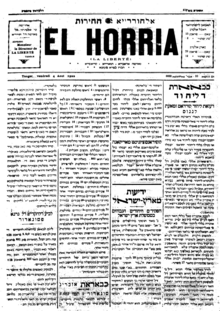Salomon Benaioun
Salomon Benaïoun | |
|---|---|
| Born | 1867 |
| Died | 1921 |
| Nationality | Moroccan |
Salomon Benaïoun (Arabic: سليمان بن حيّون Sulaymān bin Ḥayyūn,[1] Hebrew: שלמה ן' חייון Solomon Ben Hayun; 1867-1921)[2] was a Moroccan Jewish printer and journalist born in Oran in Algeria,[3] whose family originally hailed from Tetouan.[4] He moved to Tangier at the invitation of Haïm Benchimol (1834–1915), an important businessman and collaborator with the French.[3][5]
He studied printing in Paris.[2] He invested in modern printing equipment, which he sent to Tangier where he established the French Printing House on Qadi Street.[2] He also had a photography studio.[2]

He started the newspapers Kol Israel (1891),[6] Mébasser Tov (1894-1895), and Moghrabi (1904),[3] though these periodicals were short-lived.[7] Benaïoun also founded el Horria / La Liberté (1915-1922), which covered Jewish interests in Morocco in two different editions: one in Judeo-Arabic and one in French.[7][8]
He also owned Maṭbaʻat Sulaymān bin Ḥayyūn.[9]
References[edit]
- ^ a b العفاقي, رشيد. "الصحافة اللبنانية الهاجرة إلى طنجة (1889-1911م)" (PDF). مدن وثقافات (in Arabic).
- ^ a b c d Segev, Tom (2011-08-05). "The Makings of History / Tales From Tangier". Haaretz. Retrieved 2020-04-09.
- ^ a b c Baida, Jamaa (2010-10-01). "Benaioun (Ben Ayoun), Salomon". Encyclopedia of Jews in the Islamic World.
- ^ Assaraf, Robert (2005). Une certaine histoire des Juifs du Maroc: 1860-1999 (in French). p. 259. ISBN 9782350130057.
- ^ Baida, Jamaa (2010-10-01). "Benchimol, Haïm". Encyclopedia of Jews in the Islamic World.
- ^ Assaraf, Robert (2005). Une certaine histoire des juifs du Maroc: 1860-1999 (in French). Gawsewitch. ISBN 978-2-35013-005-7.
- ^ a b Bensoussan, David (May 2012). Il était Une Fois Le Maroc: Témoignages Du Passé Judéo-marocain. iUniverse. ISBN 978-1-4759-2608-8.
- ^ "El Horria". web.nli.org.il. Retrieved 2020-04-09.
- ^ "Hādhā mukhtaṣar Īḍāḥ al-burhān wa-al-ḥujjah fī tafḍīl thaghr Ṭanjah al-durrah al-thamīnah al-bahīyah ṣānahā Allāh rabb al-barīyah min kull sūʼ wa-balīyah: هذا مختصر إيضاح البرهان والحجة في تفضيل ثغر طنجة الدرة الثمينة البهية صانها الله رب البرية من كل سوء وبلية". Islamic Heritage Project - CURIOSity Digital Collections. Retrieved 2020-04-11.
